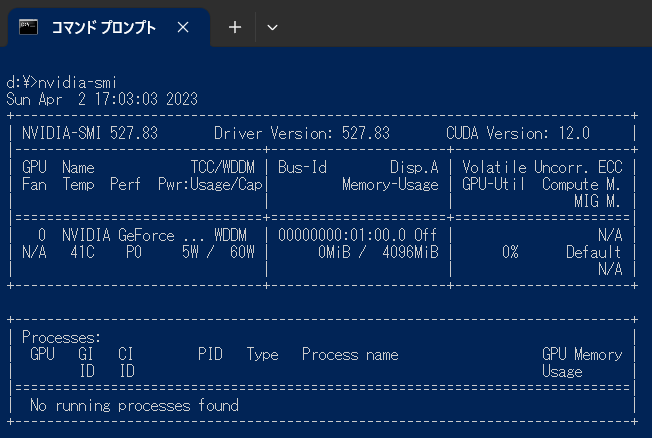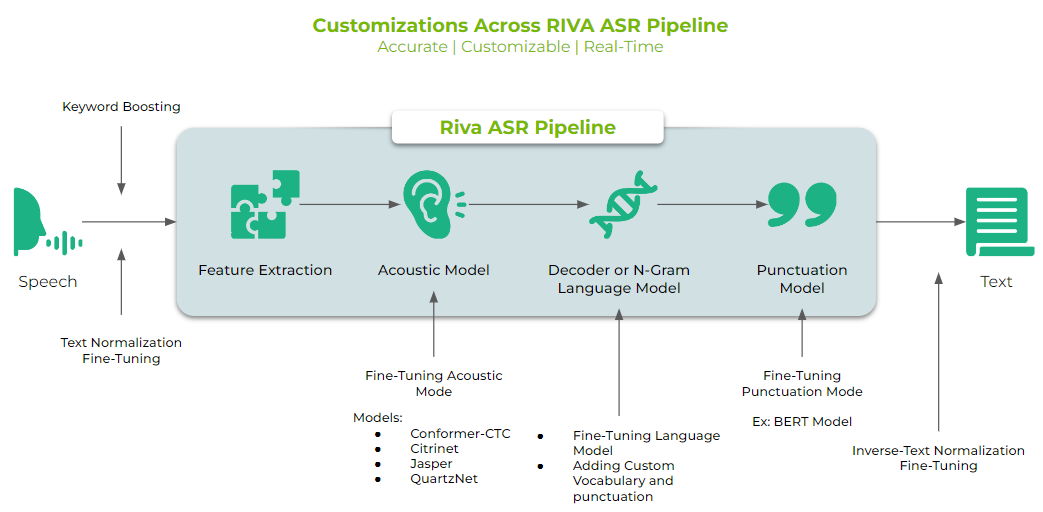[備忘録] NVIDIA System Management Interface
GeForce RTX 搭載マシンで NVIDIA システム管理インタフェイスを表示してくれる便利なツールがあったので使ってみました。
学習中に知りました。→ Azure Cognitive 空間分析コンテナー (プレビュー)
※空間分析コンテナーを使用すると、リアルタイムのストリーミング ビデオを分析して、人物間の空間的な関係、人物間の動き、物理環境内におけるオブジェクトとの相互作用を把握できます。 コンテナーは、特定のセキュリティ要件とデータ ガバナンス要件に適しています。
使用方法
コマンドプロンプト(Windows 環境から)次のコマンドを投入するだけ。
nvidia-smi
使用例
実施したローカルタイムも表示される。

引数情報
d:\>nvidia-smi -h NVIDIA System Management Interface -- v527.83 NVSMI provides monitoring information for Tesla and select Quadro devices. The data is presented in either a plain text or an XML format, via stdout or a file. NVSMI also provides several management operations for changing the device state. Note that the functionality of NVSMI is exposed through the NVML C-based library. See the NVIDIA developer website for more information about NVML. Python wrappers to NVML are also available. The output of NVSMI is not guaranteed to be backwards compatible; NVML and the bindings are backwards compatible. http://developer.nvidia.com/nvidia-management-library-nvml/ http://pypi.python.org/pypi/nvidia-ml-py/ Supported products: - Full Support - All Tesla products, starting with the Kepler architecture - All Quadro products, starting with the Kepler architecture - All GRID products, starting with the Kepler architecture - GeForce Titan products, starting with the Kepler architecture - Limited Support - All Geforce products, starting with the Kepler architecture nvidia-smi [OPTION1 [ARG1]] [OPTION2 [ARG2]] ... -h, --help Print usage information and exit. LIST OPTIONS: -L, --list-gpus Display a list of GPUs connected to the system. -B, --list-excluded-gpus Display a list of excluded GPUs in the system. SUMMARY OPTIONS: <no arguments> Show a summary of GPUs connected to the system. [plus any of] -i, --id= Target a specific GPU. -f, --filename= Log to a specified file, rather than to stdout. -l, --loop= Probe until Ctrl+C at specified second interval. QUERY OPTIONS: -q, --query Display GPU or Unit info. [plus any of] -u, --unit Show unit, rather than GPU, attributes. -i, --id= Target a specific GPU or Unit. -f, --filename= Log to a specified file, rather than to stdout. -x, --xml-format Produce XML output. --dtd When showing xml output, embed DTD. -d, --display= Display only selected information: MEMORY, UTILIZATION, ECC, TEMPERATURE, POWER, CLOCK, COMPUTE, PIDS, PERFORMANCE, SUPPORTED_CLOCKS, PAGE_RETIREMENT, ACCOUNTING, ENCODER_STATS, SUPPORTED_GPU_TARGET_TEMP, VOLTAGE FBC_STATS, ROW_REMAPPER Flags can be combined with comma e.g. ECC,POWER. Sampling data with max/min/avg is also returned for POWER, UTILIZATION and CLOCK display types. Doesn't work with -u or -x flags. -l, --loop= Probe until Ctrl+C at specified second interval. -lms, --loop-ms= Probe until Ctrl+C at specified millisecond interval. SELECTIVE QUERY OPTIONS: Allows the caller to pass an explicit list of properties to query. [one of] --query-gpu Information about GPU. Call --help-query-gpu for more info. --query-supported-clocks List of supported clocks. Call --help-query-supported-clocks for more info. --query-compute-apps List of currently active compute processes. Call --help-query-compute-apps for more info. --query-accounted-apps List of accounted compute processes. Call --help-query-accounted-apps for more info. --query-retired-pages List of device memory pages that have been retired. Call --help-query-retired-pages for more info. --query-remapped-rows Information about remapped rows. Call --help-query-remapped-rows for more info. [mandatory] --format= Comma separated list of format options: csv - comma separated values (MANDATORY) noheader - skip the first line with column headers nounits - don't print units for numerical values [plus any of] -i, --id= Target a specific GPU or Unit. -f, --filename= Log to a specified file, rather than to stdout. -l, --loop= Probe until Ctrl+C at specified second interval. -lms, --loop-ms= Probe until Ctrl+C at specified millisecond interval. DEVICE MODIFICATION OPTIONS: [any one of] -e, --ecc-config= Toggle ECC support: 0/DISABLED, 1/ENABLED -p, --reset-ecc-errors= Reset ECC error counts: 0/VOLATILE, 1/AGGREGATE -c, --compute-mode= Set MODE for compute applications: 0/DEFAULT, 1/EXCLUSIVE_THREAD (DEPRECATED), 2/PROHIBITED, 3/EXCLUSIVE_PROCESS -dm, --driver-model= Enable or disable TCC mode: 0/WDDM, 1/TCC -fdm, --force-driver-model= Enable or disable TCC mode: 0/WDDM, 1/TCC Ignores the error that display is connected. --gom= Set GPU Operation Mode: 0/ALL_ON, 1/COMPUTE, 2/LOW_DP -lgc --lock-gpu-clocks= Specifies <minGpuClock,maxGpuClock> clocks as a pair (e.g. 1500,1500) that defines the range of desired locked GPU clock speed in MHz. Setting this will supercede application clocks and take effect regardless if an app is running. Input can also be a singular desired clock value (e.g. <GpuClockValue>). Optionally, --mode can be specified to indicate a special mode. -m --mode= Specifies the mode for --locked-gpu-clocks. Valid modes: 0, 1 -rgc --reset-gpu-clocks Resets the Gpu clocks to the default values. -lmc --lock-memory-clocks= Specifies <minMemClock,maxMemClock> clocks as a pair (e.g. 5100,5100) that defines the range of desired locked Memory clock speed in MHz. Input can also be a singular desired clock value (e.g. <MemClockValue>). -rmc --reset-memory-clocks Resets the Memory clocks to the default values. -lmcd --lock-memory-clocks-deferred= Specifies memClock clock to lock. This limit is applied after GPU reset. Note that, this limit is persistence across system reboots. -rmcd --reset-memory-clocks-deferred Resets the deferred Memory clocks applied. -ac --applications-clocks= Specifies <memory,graphics> clocks as a pair (e.g. 2000,800) that defines GPU's speed in MHz while running applications on a GPU. -rac --reset-applications-clocks Resets the applications clocks to the default values. -pl --power-limit= Specifies maximum power management limit in watts. -cc --cuda-clocks= Overrides or restores default CUDA clocks. In override mode, GPU clocks higher frequencies when running CUDA applications. Only on supported devices starting from the Volta series. Requires administrator privileges. 0/RESTORE_DEFAULT, 1/OVERRIDE -am --accounting-mode= Enable or disable Accounting Mode: 0/DISABLED, 1/ENABLED -caa --clear-accounted-apps Clears all the accounted PIDs in the buffer. --auto-boost-default= Set the default auto boost policy to 0/DISABLED or 1/ENABLED, enforcing the change only after the last boost client has exited. --auto-boost-permission= Allow non-admin/root control over auto boost mode: 0/UNRESTRICTED, 1/RESTRICTED -mig --multi-instance-gpu= Enable or disable Multi Instance GPU: 0/DISABLED, 1/ENABLED Requires root. -gtt --gpu-target-temp= Set GPU Target Temperature for a GPU in degree celsius. Requires administrator privileges [plus optional] -i, --id= Target a specific GPU. -eow, --error-on-warning Return a non-zero error for warnings. UNIT MODIFICATION OPTIONS: -t, --toggle-led= Set Unit LED state: 0/GREEN, 1/AMBER [plus optional] -i, --id= Target a specific Unit. SHOW DTD OPTIONS: --dtd Print device DTD and exit. [plus optional] -f, --filename= Log to a specified file, rather than to stdout. -u, --unit Show unit, rather than device, DTD. --debug= Log encrypted debug information to a specified file. Device Monitoring: dmon Displays device stats in scrolling format. "nvidia-smi dmon -h" for more information. daemon Runs in background and monitor devices as a daemon process. This is an experimental feature. Not supported on Windows baremetal "nvidia-smi daemon -h" for more information. replay Used to replay/extract the persistent stats generated by daemon. This is an experimental feature. "nvidia-smi replay -h" for more information. Process Monitoring: pmon Displays process stats in scrolling format. "nvidia-smi pmon -h" for more information. NVLINK: nvlink Displays device nvlink information. "nvidia-smi nvlink -h" for more information. CLOCKS: clocks Control and query clock information. "nvidia-smi clocks -h" for more information. ENCODER SESSIONS: encodersessions Displays device encoder sessions information. "nvidia-smi encodersessions -h" for more information. FBC SESSIONS: fbcsessions Displays device FBC sessions information. "nvidia-smi fbcsessions -h" for more information. vGPU Scheduler Logs: vgpu-scheduler-logs Displays device scheduler log entries on vGPU host. "nvidia-smi vgpu-scheduler-logs -h" for more information. vGPU Scheduler Capabilities: vgpu-scheduler-caps Displays vGPU scheduler capabilities on vGPU host. "nvidia-smi vgpu-scheduler-caps -h" for more information. COMPUTE POLICY: compute-policy Control and query compute policies. "nvidia-smi compute-policy -h" for more information. BOOST SLIDER: boost-slider Control and query boost sliders. "nvidia-smi boost-slider -h" for more information. POWER HINT: power-hint Estimates GPU power usage. "nvidia-smi power-hint -h" for more information. BASE CLOCKS: base-clocks Query GPU base clocks. "nvidia-smi base-clocks -h" for more information. COUNTER COLLECTION UNIT: ccu Control and query counter collection unit. "nvidia-smi ccu -h" for more information. Please see the nvidia-smi documentation for more detailed information. d:\>
冒頭の説明箇所のみ和訳
NVIDIA システム管理インターフェイス — v527.83
NVSMI は、Tesla および一部の Quadro デバイスの監視情報を提供します。
データは、標準出力またはファイルを介して、プレーン テキストまたは XML 形式で表示されます。
NVSMI は、デバイスの状態を変更するためのいくつかの管理操作も提供します。
NVSMI の機能は、NVML C ベースのライブラリ。 NVML の詳細については、NVIDIA 開発者の Web サイトを参照してください。
NVML への Python ラッパーも利用できます。 NVSMI の出力は次のとおりです。
下位互換性は保証されていません。 NVML とバインディングが逆になっている
互換性。
http://developer.nvidia.com/nvidia-management-library-nvml/
http://pypi.python.org/pypi/nvidia-ml-py/
サポートされている製品:
- フルサポート
- Kepler アーキテクチャ以降のすべての Tesla 製品
- Kepler アーキテクチャ以降のすべての Quadro 製品
- Kepler アーキテクチャをはじめとするすべての GRID 製品
- Kepler アーキテクチャをはじめとする GeForce Titan 製品
- 限定サポート
- Kepler アーキテクチャ以降のすべての Geforce 製品
nvidia-smi [オプション1 [ARG1]] [オプション2 [ARG2]] … -h, –help 使用情報を出力して終了します。
- Kepler アーキテクチャ以降のすべての Geforce 製品
まとめ
再び、https://learn.microsoft.com/ja-jp/azure/cognitive-services/computer-vision/spatial-analysis-container を参照し自習に戻ります。
以上、ご覧いただき有難うございました。


![[資格取得] IBM Cloud for Professional Architect v6 (合格体験談)](https://www.fxfrog.com/wp-content/themes/newscrunch/assets/images/no-preview.jpg)





